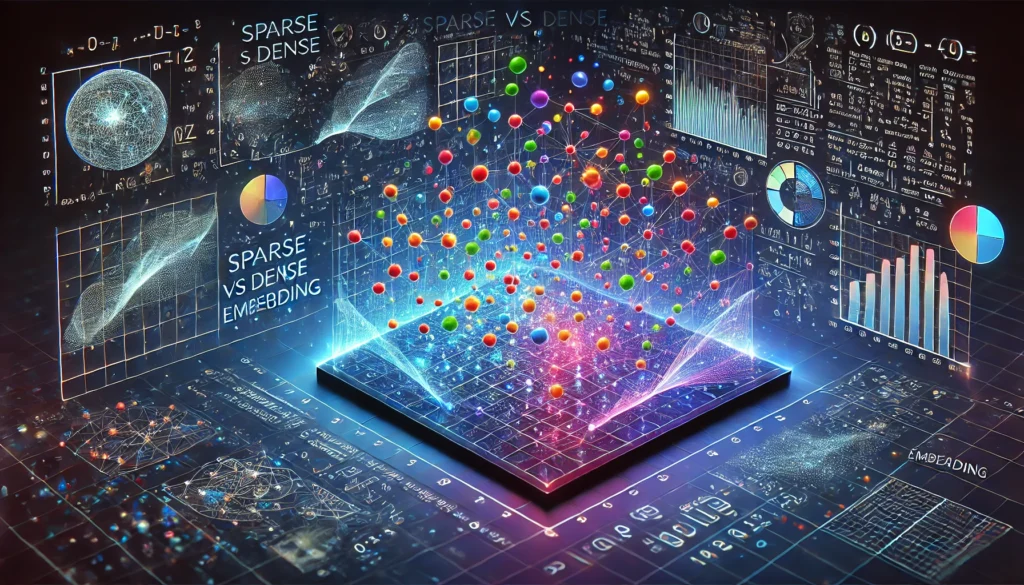Sparse Embeddings vs. Dense Embeddings : Things you must know
Introduction
In the fields of machine learning and natural language processing (NLP), embeddings are a fundamental concept used to represent data in a way that computers can understand and process. Embeddings transform raw data, such as words, sentences, or images, into numerical vectors. These vectors capture essential features of the data, enabling algorithms to perform tasks like classification, clustering, and prediction.
There are two primary types of embeddings: sparse embeddings and dense embeddings. Each has its own characteristics, advantages, and use cases. This article explores the differences between sparse and dense embeddings, their applications, and when to use each type.

What is an Embedding?
An embedding is a numerical representation of data, typically in the form of a vector. It maps high-dimensional, discrete data (like words or categories) into a lower-dimensional, continuous vector space. Embeddings are crucial because they allow machines to process and analyze data that is otherwise unstructured or symbolic.
For example, in NLP, words are represented as vectors so that machines can understand their meanings, relationships, and contexts. Embeddings can be sparse or dense, depending on how they are constructed and the information they capture.
Sparse Embeddings
Characteristics
Sparse embeddings are high-dimensional vectors where most elements are zero. They are often used in traditional machine learning and NLP methods. Key characteristics include:
- High-dimensionality: The dimensionality of sparse embeddings is typically equal to the size of the vocabulary or feature space.
- Sparsity: Most elements in the vector are zero, with only a few non-zero values.
- Interpretability: Each dimension often corresponds to a specific feature or word, making sparse embeddings easy to interpret.
- Memory-intensive: Storing sparse embeddings can be inefficient due to the large number of zeros.
Examples
- One-hot Encoding:
- Each word is represented as a vector where one element is
1(indicating the presence of the word) and all others are0. - Example: Vocabulary =
["cat", "dog", "bird"]- “cat” =
[1, 0, 0] - “dog” =
[0, 1, 0] - “bird” =
[0, 0, 1]
- “cat” =
- Each word is represented as a vector where one element is
- TF-IDF (Term Frequency-Inverse Document Frequency):
- Represents words based on their importance in a document relative to a corpus.
- Example: A document with the word “cat” appearing frequently might have a TF-IDF vector like
[0.8, 0, 0].
Use Cases
- Traditional NLP tasks like text classification and information retrieval.
- Bag-of-words models.
- Situations where interpretability is important.
Dense Embeddings
Characteristics
Dense embeddings are low-dimensional vectors where most or all elements are non-zero. They are commonly used in modern deep learning models. Key characteristics include:
- Low-dimensionality: The dimensionality is much smaller than the vocabulary size (e.g., 50, 100, or 300 dimensions).
- Dense values: All or most elements in the vector are non-zero and contain real numbers.
- Learned representations: The values are learned during training, capturing semantic relationships between words or entities.
- Efficient: Dense vectors are more memory-efficient and computationally faster to process.
Examples
- Word2Vec:
- Maps words to dense vectors based on their co-occurrence in a corpus.
- Example: “king” =
[0.25, -0.76, 0.12, ..., 0.45](a 300-dimensional vector).
- GloVe (Global Vectors for Word Representation):
- Combines global statistics with local context to generate word embeddings.
- Example: “queen” =
[0.30, -0.70, 0.15, ..., 0.50].
- BERT (Bidirectional Encoder Representations from Transformers):
- Generates contextual embeddings where the same word can have different embeddings depending on its context.
- Example: The word “bank” in “river bank” and “bank account” will have different embeddings.
Use Cases
- Modern NLP tasks like machine translation, sentiment analysis, and question answering.
- Deep learning models that require capturing semantic relationships and context.
Key Differences
| Feature | Sparse Embeddings | Dense Embeddings |
|---|---|---|
| Dimensionality | High (e.g., size of vocabulary) | Low (e.g., 50, 100, 300 dimensions) |
| Sparsity | Mostly zeros | Mostly non-zero values |
| Interpretability | High (each dimension has meaning) | Low (dimensions are abstract) |
| Memory Usage | Inefficient (due to sparsity) | Efficient |
| Semantic Capture | Limited (no semantic relationships) | Strong (captures semantic meaning) |
| Training | Not learned (handcrafted) | Learned during training |
| Use Cases | Traditional NLP | Modern deep learning NLP |
Examples Comparison
Sparse Embedding (One-hot Encoding)
- Vocabulary:
["cat", "dog", "bird"] - “cat”:
[1, 0, 0] - “dog”:
[0, 1, 0] - “bird”:
[0, 0, 1]
Dense Embedding (Word2Vec)
- “cat”:
[0.25, -0.76, 0.12] - “dog”:
[0.30, -0.70, 0.15] - “bird”:
[0.10, -0.80, 0.20]
When to Use Which?
Use Sparse Embeddings When:
- You need interpretability (e.g., understanding which features are important).
- You’re working with small datasets or traditional NLP methods.
- Memory and computational efficiency are not critical concerns.
Use Dense Embeddings When:
- You need to capture semantic relationships and context.
- You’re working with large datasets and modern deep learning models.
- Memory and computational efficiency are important.
Conclusion
Sparse and dense embeddings serve different purposes in machine learning and NLP. Sparse embeddings are interpretable and suitable for traditional methods, while dense embeddings are efficient and powerful for modern deep learning tasks. Understanding the differences between these two types of embeddings is crucial for choosing the right approach for your specific application. Whether you’re working on a simple text classification task or building a state-of-the-art language model, embeddings are a key tool in your machine learning toolkit.





